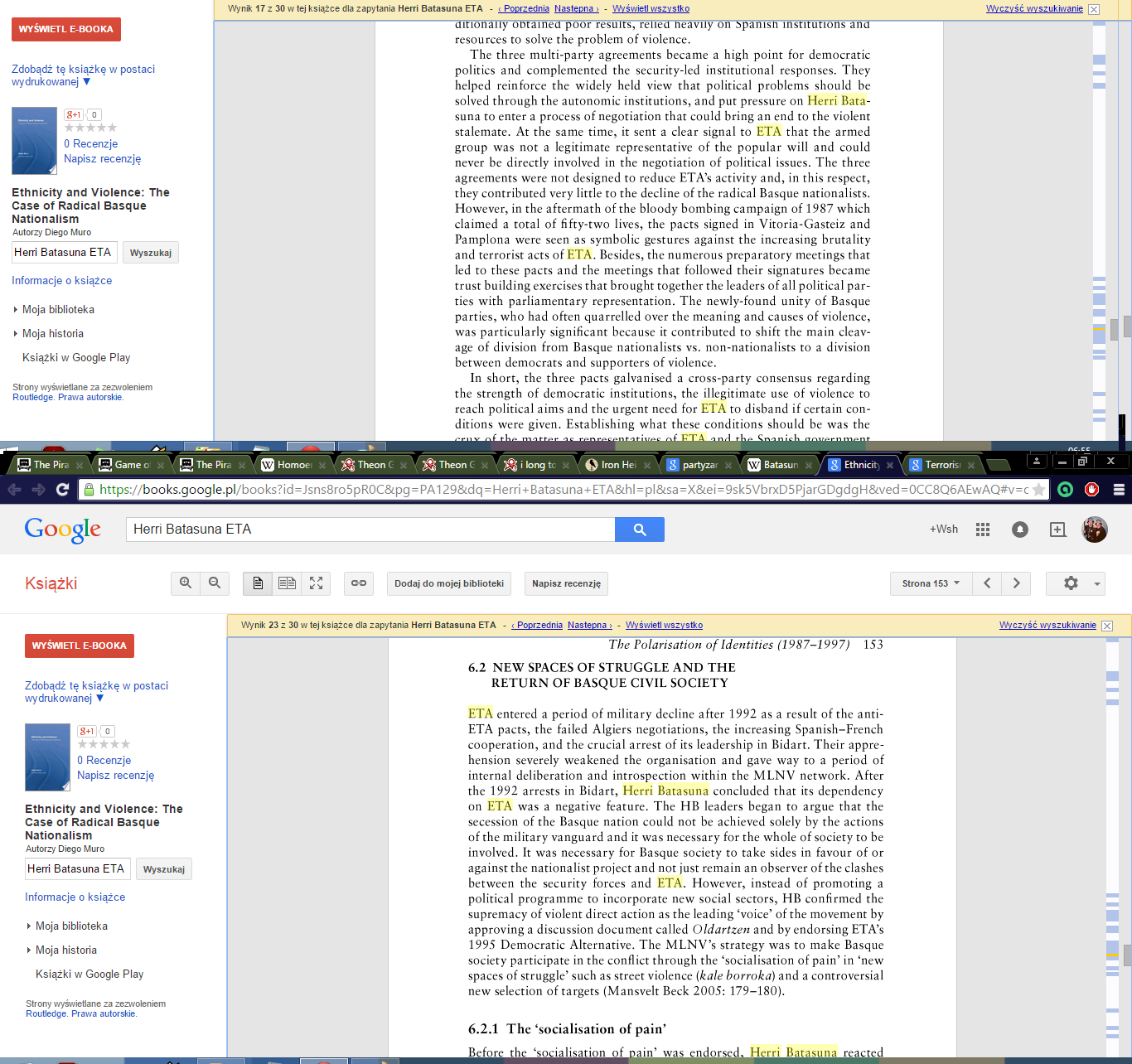bat 7

WYŚWIETL E-BO OKA
Zdobądź tę książkę w postaci wydrukowanej ▼

8+1 ,o|
★ ★★★★
0 Recenzje Napisz recenzję
Ethnicity and Violence: The Case of Radical Basque Nationalism
Autorzy Diego Muro
Herri Batasuna ETA Wyszukaj
Informacje o książce
► Moja biblioteka
► Moja historia Książki w Google Play
Strony wyświetlane za zezwoleniem Routledge. Prawa autorskie.
[^j The Piri [^] Gamę
e

Wynik 17 z 30 w tej książce dla zapytania Herri Batasuna ETA - < Poprzednia Następna > - Wyświetl wszystko
uitionaiiy oDtainea poor resuits, reiiea neavuy on spamsn institutions ana resources to solve the problem of yiolence.
The three multi-party agreements became a high point for democratic politics and complcmentcd the security-lcd institutional responses. They helped reinforce the widely held view that political problems should be solved through the autonomie institutions, and put pressure on Herri Batasuna to enter a process of negotiation that eould bring an end to the violent stalemate. At the same time, it sent a elear signal to ETA that the armed group was not a legitimate representative of the popular will and eould never be directly involved in the negotiation of political issues. The three agreements were not designed to reduee ETA’s activity and, in this respeet, they eontributed very little to the decline of the radical Basque nationalists. However, in the aftermath of the bloody bombing eampaign of 1987 which claimed a total of fifty-two lives, the pacts signed in Vitoria-Gasteiz and Pamplona were seen as symbolic gestures against the inereasing brutality and terrorist aets of F.TA. Bcsidcs, the numerous preparatory meetings that led to these pacts and the meetings that followed their signatures became trust buildingexercises that brought together the leadersof all political par-ties with parliamentary representation. The newly-found unity of Basque parties, who had often quarrelled over the meaning and eauses of violenee, was particularly significant because it eontributed to shift the main cleav-age of division from Basquc nationalists vs. non-nationalists to a division between dcmoerats and supporters of violcnce.
In short, the three pacts galvanised a cross-party consensus regarding the strength of democratic institutions, the illegitimate use of violence to reach political aims and the urgent need for ETA to disband if certain con-ditions were given. Establishing what these conditions should be was the
k'T X aaA tkg n l‘|lwinirrr n ivl,‘nt
W/czyść wyszukiwanie

Homoe ^TheonC ^ Theon C ^ilongtc Q Iron He S partyze 0 Batasui S I Ethnicrt S Terroris

— x
S https://books.google.pl/books?id=Jsns8ro5pR0C&pg = PA129&dq = Herri+ Batasuna + ETA&hl = pl&sa=X&ei=9sk5VbrxD5PjarGDgdgH&ved=0CC8Q6AEwAQ#v=c
Herri Batasuna ETA
+Wsh
|
Książki |
| CL | o. | |
i 11 55 |
CO |
Dodaj do mojej biblioteki |
Napisz recenzję |
Strona 153 ^ |
< > |
O - |
Wynik 23 z 30 w tej książce dla zapytania Herri Batasuna ETA - < Poprzednia Następna > - Wyświetl wszystko
W/czyść wyszukiwanie
WYŚWIETL E-BO OKA
Zdobądź tę książkę w postaci wydrukowanej ▼
■ 8+1 o
★ ★★★★
0 Recenzje Napisz recenzję
Ethnicity and Violence: The Case of Radical Basque Nationalism
Autorzy Diego Muro
Herri Batasuna ETA Wyszukaj
Informacje o książce
► Moja biblioteka ► Moja historia Książki w Google Play
Strony wyświetlane za zezwoleniem Routledge. Prawa autorskie.
The Polarisation of Identities (19X7-1997) 153
6.2 NEW SPACES OF STRUGGLE AND THE RETURN OF BASQUE CIVIL SOCIETY
ETA entered a period of military decline after 1992 as a rcsult of the anti-ETA pacts, the failed Algiers negotiations, the inereasing Spanish-French coopcration, and the crucial arrest of its leadership in Bidart. Their appre-hension severely weakened the organisation and gave way to a period of internal deliberation and introspection within the MLNV network. After the 1992 arrests in Bidart, Herri Batasuna concluded that its dependency on ETA was a negative feature. The HB leaders began to argue that the scccssion of the Basque nation eould not be achicvcd solely by the actions of the military vanguard and it was necessary for the whole of society to be involved. It was necessary for Basque society to take sides in favour of or against the narionalist project and not just remain an observer of the clashes between the security forces and ETA. However, instead of promoting a political programme to incorporate new social secrors, HB confirmed the supremacy of violent direct action as the leading ‘voice’ of the movement by approving a discussion document cal leci O Id ar t zen and by endorsing ETA’s 1995 Democratic Alternative. The MLNV’s strategy was to make Basque society participate in the conflict through the ‘socialisation of pain’ in ‘new spaces of struggle’ such as Street violence (kale horroka) and a controversial new selection of targets (Mansvelt Beck 2005: 179-180).

6.2.1 The ‘socialisation of pain’
Wyszukiwarka
Podobne podstrony:
bat 5 WYŚWIETL E-BO OKA Zdobądź tę książkę w postaci wydrukowanej ▼ ■ g+i o ★ ★★★★ 0 Recenzje
bat 6 WYŚWIETL E-BO OKA Zdobądź tę książkę w postaci wydrukowanej ▼ 8+1 ,o
bat 7 WYŚWIETL E-BO OKA Zdobądź tę książkę w postaci wydrukowanej ▼ 8+1 ,o
bat 6 WYŚWIETL E-BO OKA Zdobądź tę książkę w postaci wydrukowanej ▼ 8+1 ,o
bat 3 -—- WYŚWIETL E-BO OKA Zdobądź tę książkę w postaci wydrukowanej ▼ ■ g+i o★ ★★★★ 0
bat 3 -—- WYŚWIETL E-BO OKA Zdobądź tę książkę w postaci wydrukowanej ▼ ■ g+i o★ ★★★★ 0
bat 1 5.2.2 Heni Batasuna Zdobądź tę książkę w postaci wydrukowanej ▼ 8+1 ,o
ETA nad?sque 1 KUP E-BOOKA-438,90 ZŁ Zdobądź tę książkę w postaci wydrukowanej ▼ 8+1 ,o
ETA nad?sque 2 KUP E-BOOKA-438,90 ZŁ KUP E-BOOKA-438,90 ZŁ Zdobądź tę książkę w postaci wydrukowanej
ETA nad?sque 3 KUP E-BOOKA-438,90 ZŁ KUP E-BOOKA-438,90 ZŁ Zdobądź tę książkę w postaci wydrukowanej
bat 9 WYŚWIETL E-BO OKA Wynik 25 z 30 w tej książce dla zapytania Herri Batasuna ETA - < Poprzedn
Image221 Funkcje te mają postać:DA = ADb = AB+AB = A@BDc = AC+BC+ABĆ = C(A+B) + CAB = CAB+CAB = AB@C
więcej podobnych podstron